- 1Department of Tourism Management, Jimei University, Xiamen, China
- 2Department of Bioenvironmental Systems Engineering, National Taiwan University, Taipei, Taiwan
- 3Department of Life Science, School of Life Science, College of Science, National Taiwan Normal University, Taipei, Taiwan
Plastic pollution is a global environmental crisis that threatens marine ecosystems and human health. This study provides a comprehensive analysis of the current state of plastic pollution in oceans worldwide. We examined data on global plastic production, annual estimates of plastic emissions to oceans from different countries, surface plastic mass by ocean basin, the share of global plastic waste emitted to the ocean, the share of ocean plastics that come from the largest emitting rivers, microplastics in the surface ocean, and plastic mass and particles across the world surface ocean. Our analysis revealed alarming trends, such as the significant increase in plastic production since the 1950s and the projected estimate of up to 12,000 million metric tons of plastic waste in the natural environment by 2050. Additionally, we found that more than 1000 rivers account for 80% of global annual emissions, with Asia contributing the highest estimate of plastic emissions, followed by Africa, South America, North America, Europe, and Oceania. Furthermore, our findings showed that the largest contributors to ocean plastic waste are macroplastics, mesoplastics, and microplastics, with small microplastics dominating the percentage of surface ocean plastic by particle count. The recycling and reuse of waste plastics implement the concept of sustainable development of recycling and offsets the carbon emissions in the environment, potentially obtaining more carbon credits. Our findings highlight the urgent need for coordinated global efforts to reduce plastic waste and prevent further harm to our oceans, incorporating recycling and reuse strategies as key components of comprehensive control measures.
1 Introduction
Plastic pollution has become a significant environmental and health challenge worldwide. The production and consumption of plastic have increased significantly over the past few decades, with global plastic production reaching 368 million metric tons in 2019 (Europe, 2020). While plastic has many benefits in various sectors, including food packaging, medical supplies, and construction, its indiscriminate disposal and lack of proper waste management have resulted in a pervasive environmental problem.
The impacts of plastic pollution on marine ecosystems and human well-being are severe and far-reaching. Plastic waste in the ocean harms marine species and their habitats, disrupts ecosystem functioning, and causes economic losses to fisheries and tourism (Beaumont et al., 2019). Plastic pollution also poses a threat to human health through the consumption of contaminated seafood and water, as well as through microplastic inhalation and ingestion (Smith et al., 2018). In addition, plastic pollution exacerbates climate change by contributing to greenhouse gas emissions from plastic production and disposal (Ford et al., 2022).
Given the magnitude and complexity of the plastic pollution problem, there is an urgent need for concerted efforts to reduce plastic production, consumption, and waste. Various measures have been proposed and implemented globally, including plastic bag bans, extended producer responsibility schemes, and the development of biodegradable and compostable plastics (Mallick et al., 2021). However, more comprehensive and collaborative solutions are necessary to tackle the plastic pollution problem effectively and sustainably. Control measure strategies, such as improving waste management, promoting sustainable consumption and production, increasing public awareness, and incentivizing industries to develop eco-friendly products, could play a critical role in mitigating plastic pollution (Abubakar et al., 2022). In order to awaken human attention to the marine environment, the United Nations designated June 8th as World Oceans Day starting in 2009, hoping that the world will use this to examine global issues such as marine pollution and excessive resource consumption. Given the far-reaching and devastating consequences of plastic pollution, it is essential to take swift and decisive action to address this crisis and safeguard our oceans’ health and wellbeing.
Therefore, the objectives of this study are fourfold: (i) to analyze the current and future trends in global plastic production and its potential impact on the environment, particularly in the oceans, and identify measures to reduce plastic waste, (ii) to investigate the major contributors to plastic waste in the oceans, such as rivers, countries, and continents, and identify strategies to mitigate plastic emissions from these sources, (iii) to assess the magnitude and distribution of microplastics in the world’s surface oceans, including their size and composition, and (iv) to propose methods and strategies to monitor and control proliferation of ocean plastics.
2 Materials and methods
To estimate the annual emissions of plastics to oceans, we adopted the platform of “Our World in Data” for data analysis. “Our World in Data” is a prominent online publication and data platform known for its credible and comprehensive approach to presenting global trends. By sourcing data from reputable international organizations, governments, and research institutions, it ensures the accuracy and reliability of its information. Through visually engaging charts, graphs, and interactive tools, the platform transforms complex data into easily understandable visualizations, aiding users in quickly grasping key insights. Its global perspective enables users to compare countries and regions across a wide range of topics, while its historical context feature allows for a deeper understanding of long-term trends. As an educational resource, “Our World in Data” is utilized by students, researchers, educators, and policymakers alike, offering open access to valuable knowledge. With its interdisciplinary insights, regular updates, and commitment to transparent information sharing, the platform stands as an invaluable tool for comprehending the complex dynamics that shape our world. (Ritchie and Roser, 2018).
The Our World in Data collected data on global plastic production from various sources, including industry reports and academic studies. Firstly, to analyze the current and future trends in global plastic production, the surface plastic mass by ocean basin shown on the Our World in Data platform were analyzed by using data from previous studies (Eriksen et al., 2014; Meijer et al., 2021). Secondly, to investigate the major contributors to plastic waste in the oceans, the share of global plastic waste emitted to ocean and the share of ocean plastics that come from the largest emitting rivers were evaluated by adopting data from Meijer et al. (2021). Thirdly, to assess the magnitude and distribution of microplastics in the world’s surface oceans, microplastics in the surface ocean and plastic mass and particles across the world surface ocean were also investigated and visualized through Our World in Data (Eriksen et al., 2014; Lebreton et al., 2019). Finally, to propose methods and strategies to monitor and control proliferation of ocean plastics, global distribution of microplastics in the surface ocean in 2019 was estimated. We also used the NOAA, National Centers for Environmental Information (NCEI) and Microplastics Database (2022) for data analysis and visualization.
3 Results
3.1 Global plastic production
If assuming consistent use patterns with current global waste management trends to 2050, it was estimated that 9000 million metric tons of plastic waste will have been recycled, 12,000 million metric tons incinerated, and 12,000 million metric tons discarded in landfills or the natural environment (Geyer et al., 2017).
Based on the estimations, Figure 1 further projected the global plastic production from 1950 to 2019. The graph illustrates a significant increase in plastic production from 2 million metric tons in 1950 to 459.75 million metric tons in 2019 with 8300 million metric tons as of virgin plastics. Based on the estimation by Geyer et al. (Geyer et al., 2017), if current plastic production trends continue, approximately as much as 12,000 million metric tons of plastic waste will be in the natural environment by 2050 (Geyer et al., 2017).

Figure 1 Annual global polymer and fiber creation. The data in this figure show the yearly accumulation of polymer resin and fibers. Analyzed by Our World in Data (Ritchie and Roser, 2018), the content relies on foundational work by (Geyer et al., 2017).
3.2 Emitted plastics to oceans from different countries
It was estimated that more than 1000 rivers account for 80% of global annual emissions, ranging between 0.8 million to 2.7 million metric tons per year, with small urban rivers among the most polluting (Meijer et al., 2021). Based on the analyses of the previous study, Figure 2 visualizes the annual estimates of plastics with volume differences emitted to the oceans from various countries in 2019. Table 1 lists percentages of share of global plastic waste emitted to oceans from the first twenty countries and regions contribute most to plastic emissions (Meijer et al., 2021). The largest contributing country estimated was the Philippines with 4820 rivers emitting 356,371 million metric tons year−1, followed by India with 126,513 million metric tons year−1, Malaysia with 73,098 million metric tons year−1 through 1070 rivers, and China with 70,707 million metric tons year−1 through 1309 rivers (Meijer et al., 2021). We also included information of percentages of share of global plastic waste from100 countries orderly contributing to plastic emissions to oceans (Supplementary Table S1).
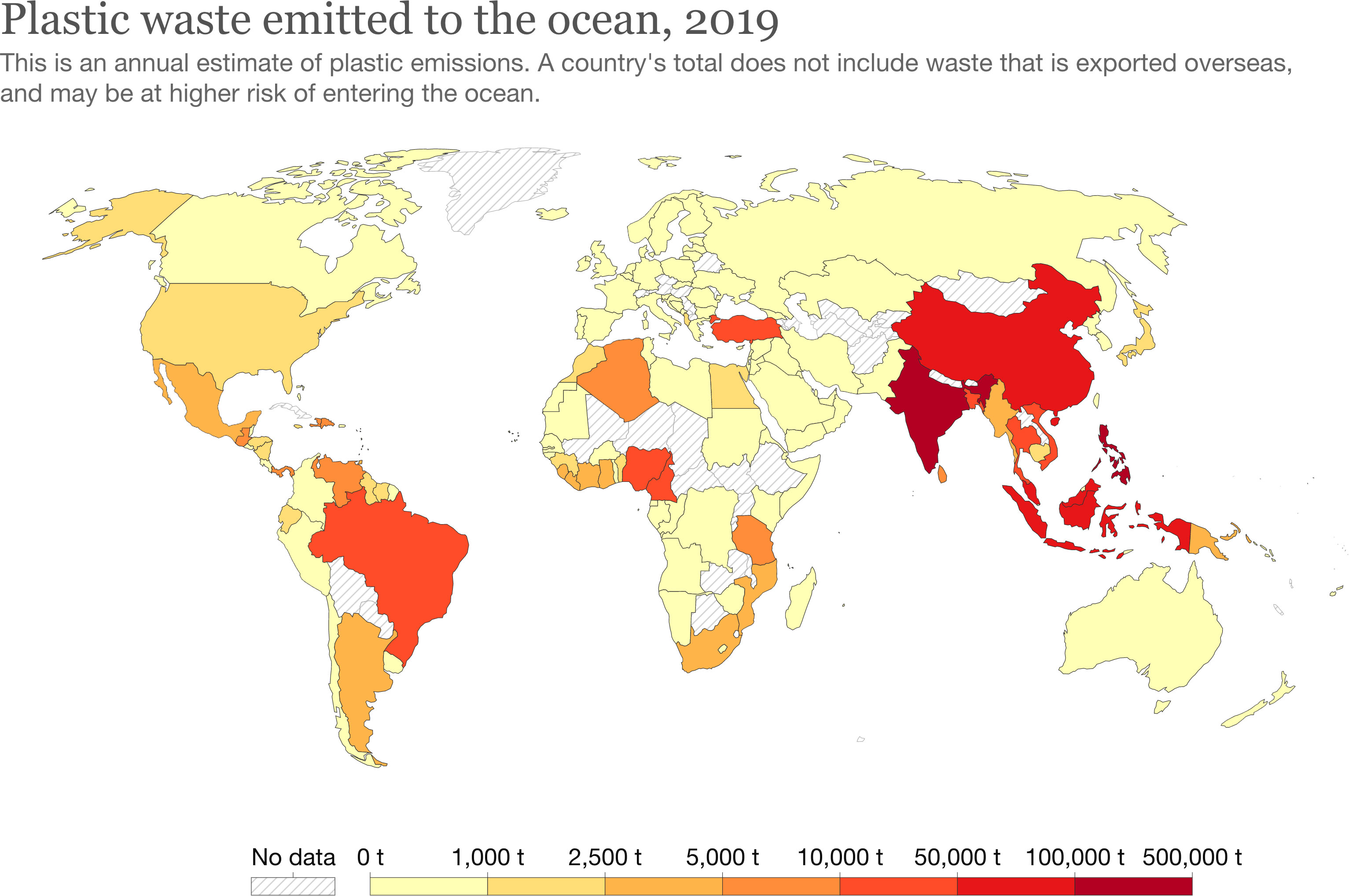
Figure 2 2019 Estimates of ocean-bound plastic. The figure indicates annual projections of plastic discharge into marine environments. Data for each country do not account for waste exported abroad, which may pose an elevated risk for ocean pollution. Analytics provided by Our World in Data (Ritchie and Roser, 2018), based on research by (Meijer et al., 2021). Notably, over 1000 rivers contribute to 80% of the global plastic inflow into oceans.
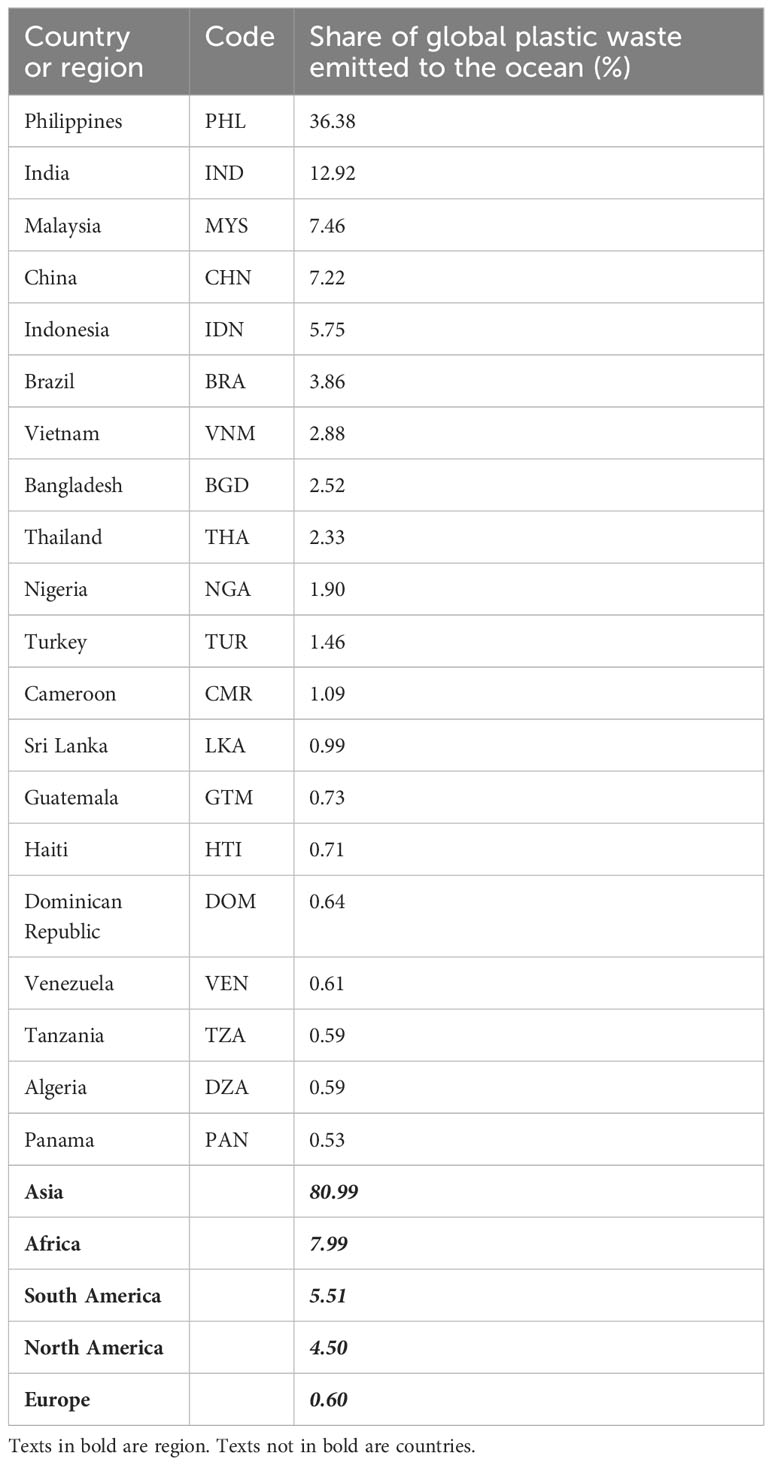
Table 1 Plastic waste emitted to the ocean tonnes per year, 2019 (top 20 countries and 5 regions) (Ritchie and Roser, 2018; Meijer et al., 2021).
3.3 Emitted plastics to oceans from six continents
Figure 3 shows the share of global plastic waste emitted to the ocean. The data indicate that an estimated 8 million metric tons of plastic waste were emitted to oceans, with the majority coming from Asia. It was found that more than 1000 rivers account for 80% of global annual emissions, ranging from 0.8 million to 2.7 million metric tons per year. Among six continents, Asia accounts for the highest estimate of plastic emissions (80.99%), followed by Africa (7.99%), South America (5.51%), North America (4.5%), Europe (0.6%), and Oceania (0.37%) (Figure 3).
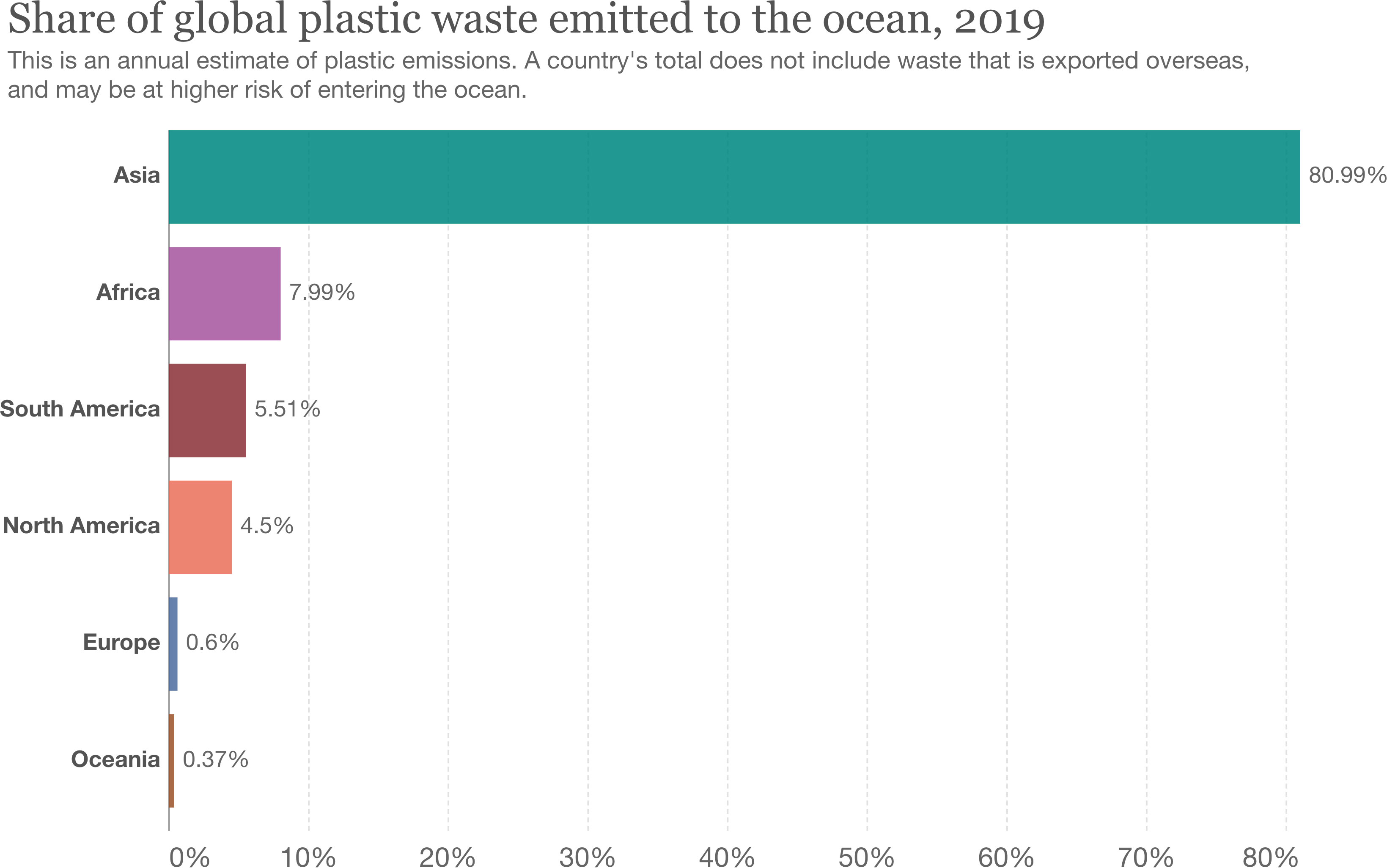
Figure 3 2019 Global oceanic plastic emission share. The figure presents yearly statistics of plastic waste entering marine ecosystems. The total for each country excludes waste for export, increasing the likelihood of oceanic contamination. Data were interpreted by Our World in Data (Ritchie and Roser, 2018), founded on the study by (Meijer et al., 2021). Notably, over 1000 rivers contribute to 80% of annual global plastic ocean entry.
Figure 4 displays the surface plastic mass by ocean basin. The global ocean (total) surface plastic mass was 268,950 tonnes. The North Pacific had the highest surface plastic mass at 96,400 tonnes, followed by the Indian Ocean (59,130 and the North Atlantic. Based on the oceanographic model of floating debris dispersal, a minimum of 5.25 trillion particles weighing 268,940 tons were estimated (Figure 4).
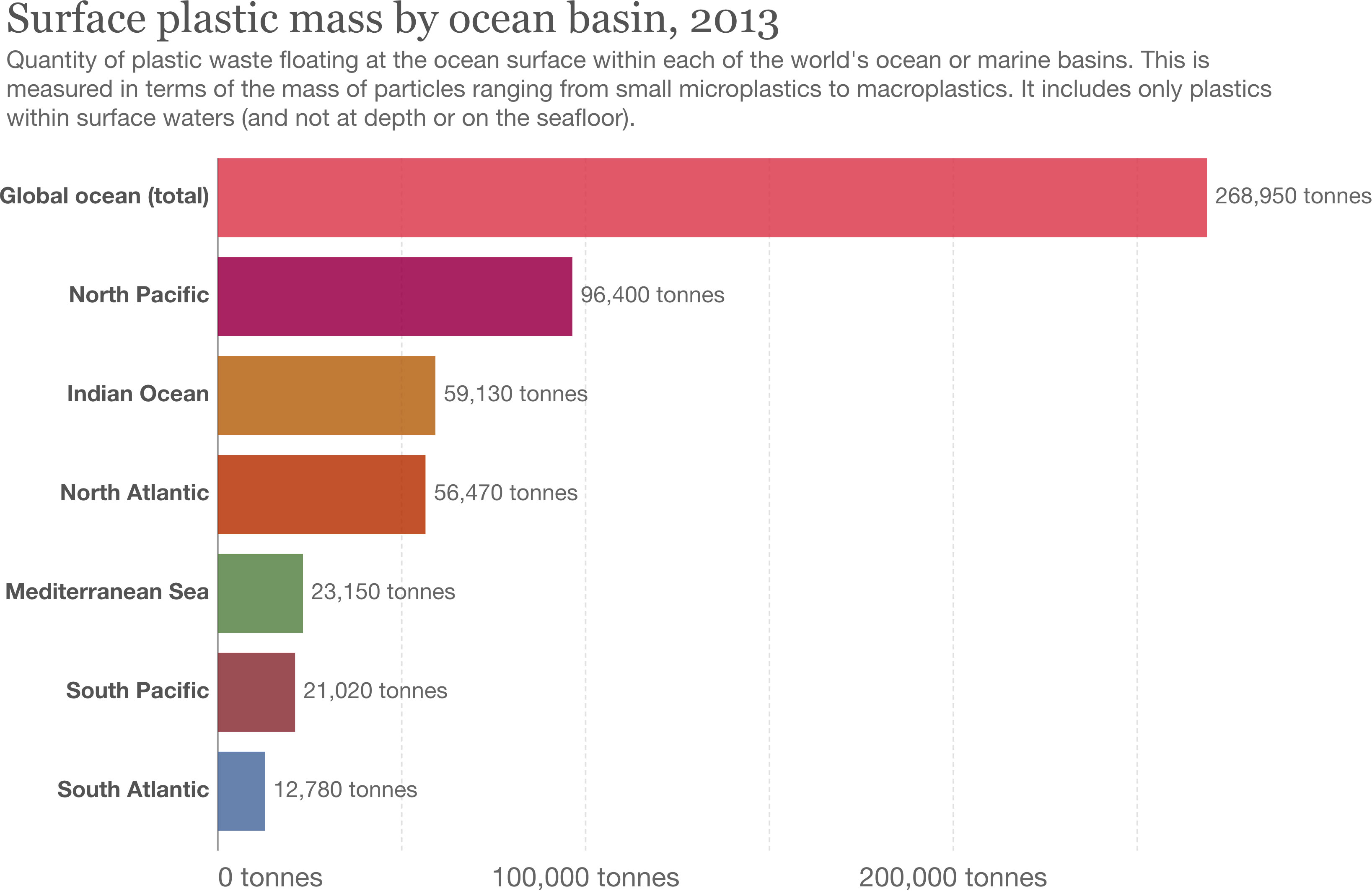
Figure 4 2013 Ocean basin surface plastic weights. The figure details the mass of floating plastic waste across global ocean basins, categorized from microplastics to larger particles. The focus is exclusively on surface-level plastics, disregarding those at greater depths or the ocean floor. Data were interpreted by Our World in Data (Ritchie and Roser, 2018), and are grounded in the study by (Eriksen et al., 2014). It’s worth noting that over 1000 rivers are responsible for 80% of plastic entering global oceans.
3.4 Emitted plastics to oceans from different rivers
Figure 5 illustrates the share of ocean plastics that come from the largest emitting rivers. In accordance with the results in Figures 2, 3, The Pasig (Philippines) is the largest contributor, accounting for 6.43% of all plastic wastes, followed by the Klang (Malaysia) for 1.33% and the Ulhas (India) for 1.33%.
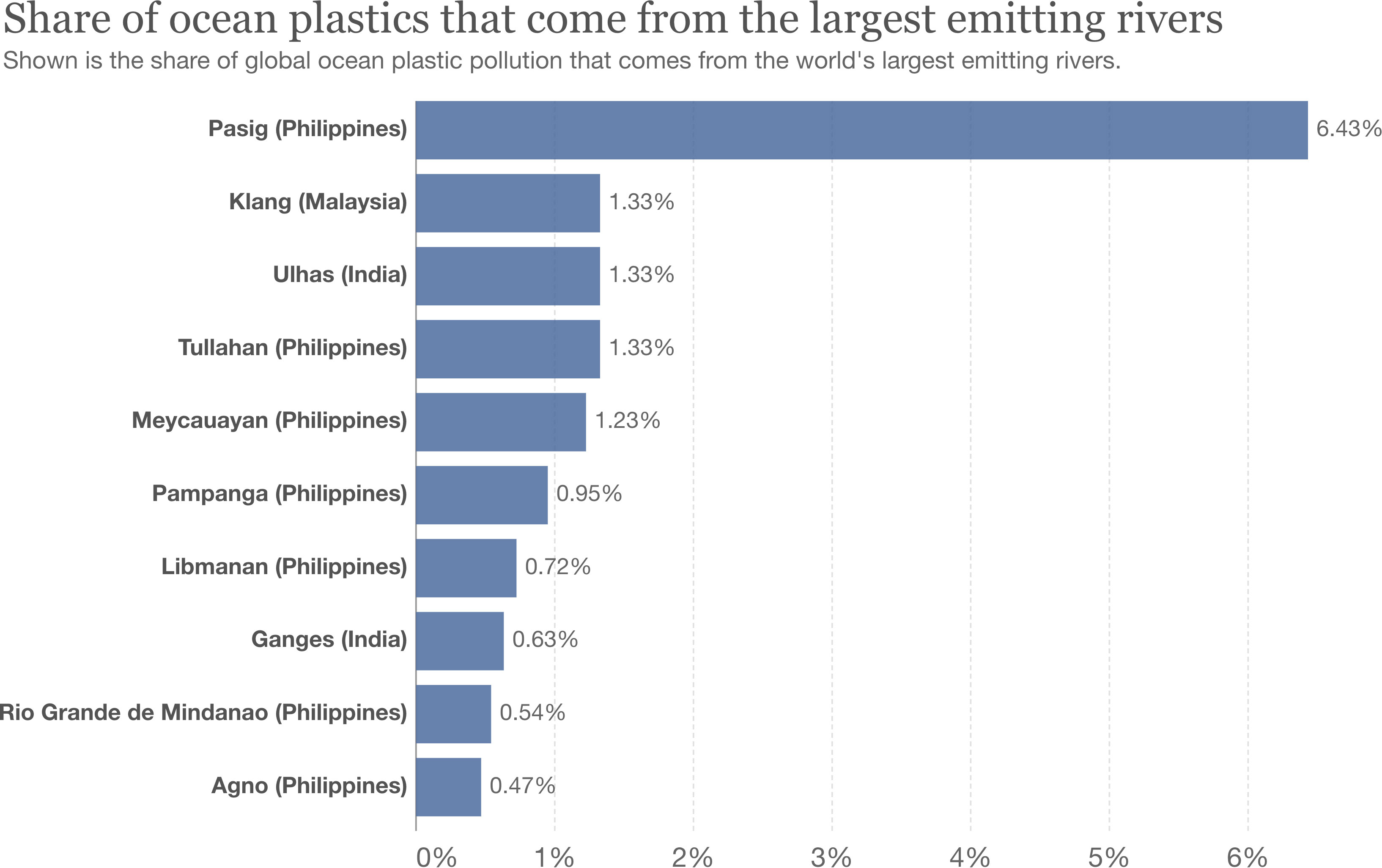
Figure 5 Major river contributors to ocean plastic. The figure delineates the percentage of oceanic plastic waste originating from the world’s most significant river sources. Over 1000 rivers contribute to a substantial 80% of the plastic entering oceans globally. Data interpretation was conducted by Our World in Data (Ritchie and Roser, 2018), based on (Meijer et al., 2021).
3.5 Prediction of microplastic in surface oceans
Figure 6 presents global accumulations of microplastics in the surface ocean under three plastic emissions scenarios. The mass of buoyant macroplastics on the global ocean surface and coastlines continue to increase with a relatively slower rate due to degradation of older objects into smaller particles if emissions of plastics into the oceans are kept constant from the year of 2020. If sources of buoyant macroplastics are stopped from the year of 2020, floating and stranded mass of macroplastics could decrease by 2050 to respectively 59% and 57% of their 2020 levels (Lebreton et al., 2019).
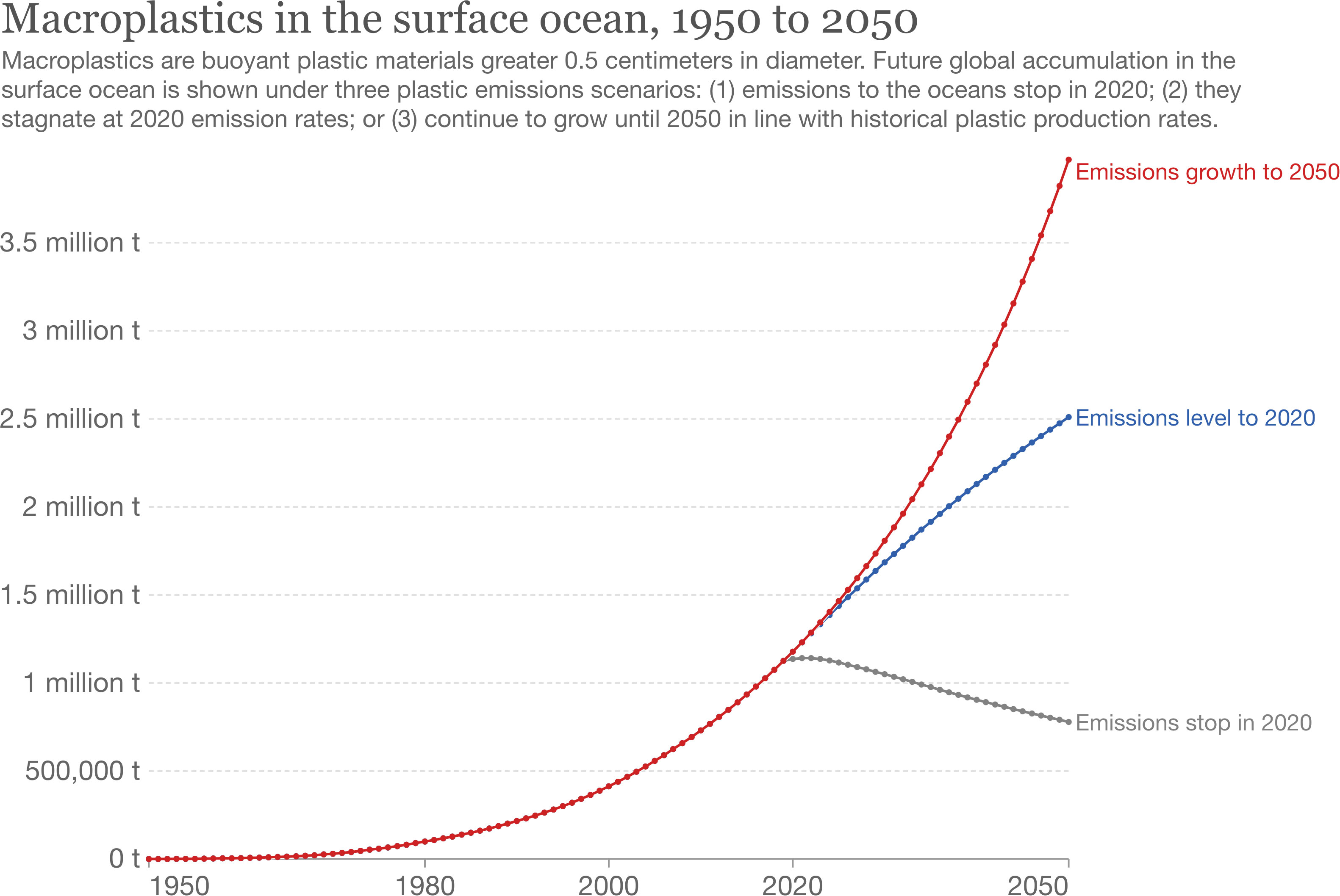
Figure 6 Oceanic macroplastic projections, 1950-2050. Macroplastics, defined as buoyant plastics larger than 0.5 cm in diameter, are the focus of this figure. It illustrates three future scenarios for macroplastic accumulation on ocean surfaces: (1) cessation of emissions after 2020; (2) maintenance of 2020 emission levels; and (3) continued growth aligned with past production rates until 2050. Data interpretation was done by Our World in Data (Ritchie and Roser, 2018), based on research by (Lebreton et al., 2019). It offers a global budget outlook for positively buoyant macroplastic waste in marine environments.
We further explored the distributions of microplastics with visualization in a global level (Figure 7). Consistent with Figures 2, 3, and 5, Philippines, India, and Malaysia have either very high (10 pieces/m3 or greater) or high (1-10 pieces/m3) concentrations of marine microplastics. Higher proportions of distributions of microplastics with ‘very high’ or ‘high’ concentrations were also observed in regions of Asia and Africa. There were also higher distributions of microplastics in high concentrations around Russia and the North Pacific Ocean (Figure 7).
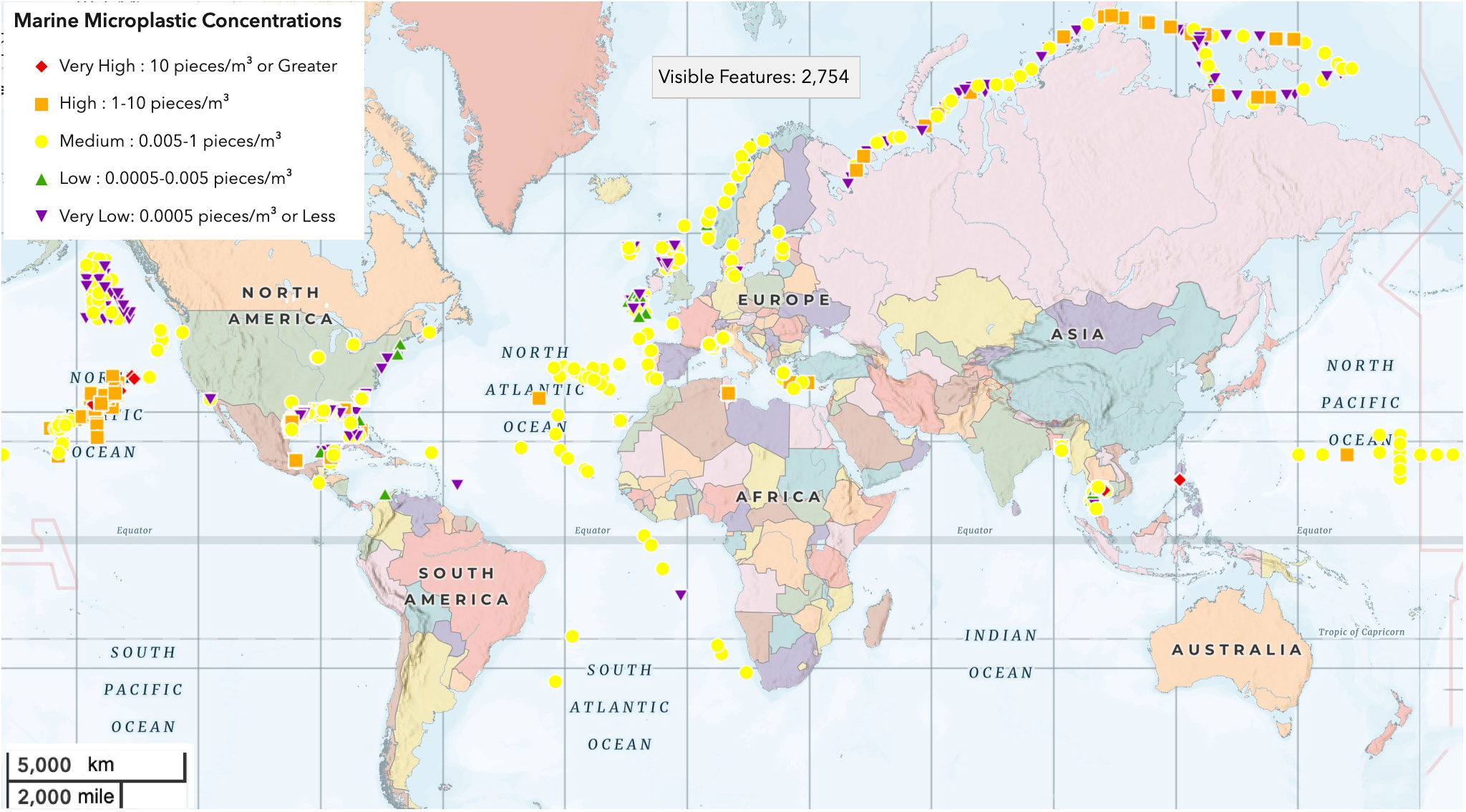
Figure 7 2019 Microplastic concentrations across global oceans. The figure utilizes varied shapes and hues to depict differing levels of surface ocean microplastic concentrations: red diamonds for very high levels (10 pieces/m³ or more), orange squares for high levels (1-10 pieces/m³), yellow circles for medium levels (0.005-1 pieces/m³), green triangles for low levels (0.0005-0.005 pieces/m³), and purple upside-down triangles for very low levels (0.0005 pieces/m³ or less). Data were sourced from the NOAA/NCEI Microplastics Database (NOAA 2022).
3.6 Microplastics across world’s surface oceans
Figure 8 displays the surface plastic by mass (tonnes) or by particle count across the world surface oceans. If counted by mass, macroplastics (>200 mm) dominate the per-centage of surface ocean plastic, followed by mesoplastics (4.76 mm-200 mm), large microplastics (1.01 mm-4.75mm), and small microplastics (0.33-1 mm) (Figure 8). If counted by particle count, small microplastics (0.33-1 mm) dominate the percentage of surface ocean plastic, followed by large microplastics (1.01 mm-4.75mm), and mesoplastics (4.76 mm-200 mm) (Figure 8).
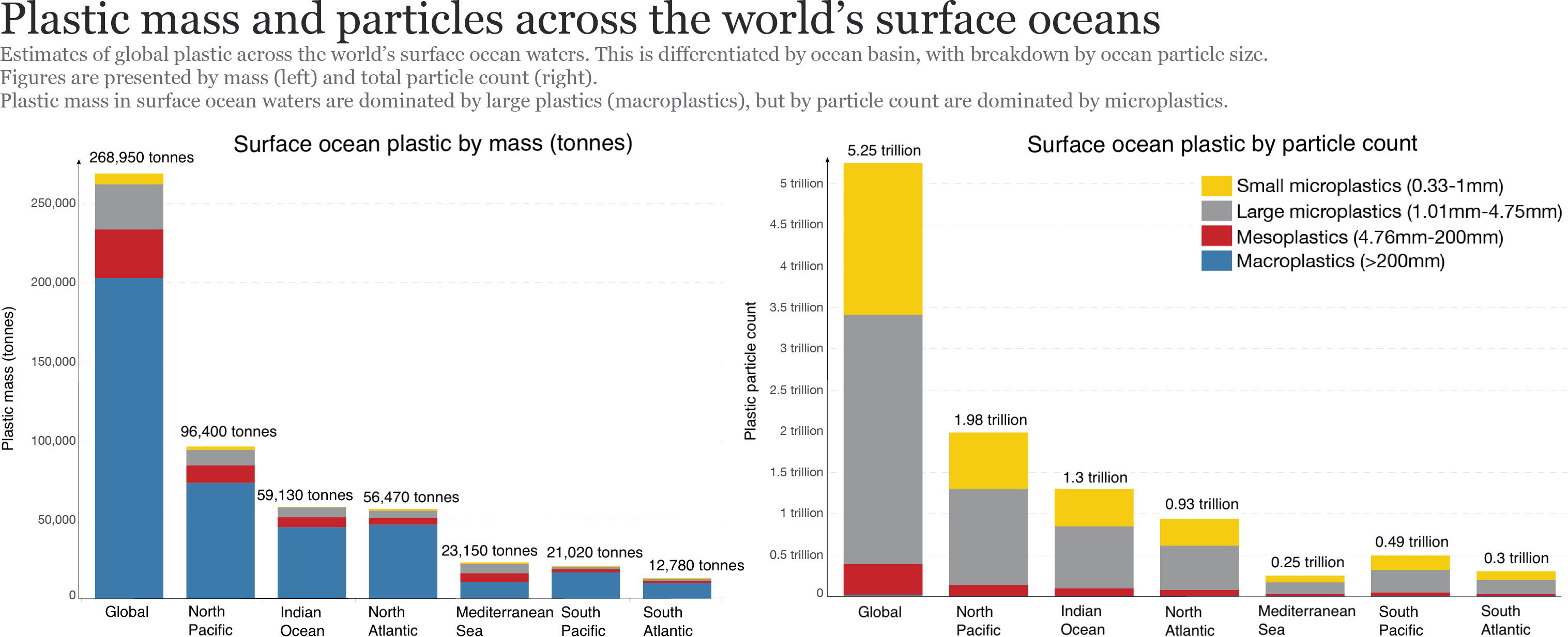
Figure 8 Plastic particles in the world’s surface ocean. Estimates of global plastic across the world’s surface ocean waters. This is differentiated by ocean basin, with breakdown by ocean particle size. Figures are presented by mass (left) and total particle count (right). Plastic mass in surface ocean waters are dominated by large plastics (macroplastics), but by particle count are dominated by microplastics. (Results were analyzed by Our World in Data (Ritchie and Roser, 2018), based on the original study of (Eriksen et al., 2014). Plastic Pollution in the World’s Oceans: More than 5 Trillion Plastic Pieces Weighing over 250,000 Tons Afloat at sea.).
4 Discussion
4.1 Plastic production and ocean pollution
Plastic production has reached an all-time high, with over 360 million tons of plastic produced globally in 2018. We also found that global plastic production was 459.75 million metric tons in 2019 (Geyer et al., 2017). This high production rate has led to an increase in plastic pollution, with millions of tons of plastic waste being dumped into the oceans each year. According to Jambeck et al. (2015), up to 13 million tons of plastic waste enters the oceans each year, threatening marine ecosystems and human health.
Plastic pollution in the oceans is a global issue, with plastic waste found in all ocean basins. A study estimated that Asia is the largest contributor to plastic pollution in the oceans, accounting for 81% of the total mass of plastic waste in the oceans (Schmidt et al., 2017). It was also found that the top 20 countries responsible for plastic waste in the oceans were located in Asia and Africa, with China being the largest contributor, followed by Indonesia and the Philippines.
The effects of plastic pollution on marine ecosystems are numerous and severe. Plastic waste in the oceans can harm marine organisms through ingestion, entanglement, and physical damage. A study found that over 800 species are affected by plastic debris, including sea turtles, whales, and seabirds (Gall and Thompson, 2015). Furthermore, plastic pollution can also have economic and social impacts, affecting industries such as fisheries and tourism.
Another issue that has been raising much concerns is the macroplastics, if counted by mass, macroplastics (>200 mm) dominate the percentage of surface ocean plastic, followed by mesoplastics (4.76 mm-200 mm), large microplastics (1.01 mm-4.75mm), and small microplastics (0.33-1 mm) (Figure 7). If counted by particle count, small microplastics (0.33-1 mm) dominate the percentage of surface ocean plastic, followed by large microplastics (1.01 mm-4.75mm), and mesoplastics (4.76 mm-200 mm).
Conclusively, plastic pollution in the oceans is a complex and urgent issue that requires global cooperation and action. It is essential to reduce plastic production, improve waste management, and promote sustainable alternatives to prevent further damage to marine ecosystems and human health. With the development of new technologies and increased awareness and education, there is hope for a cleaner and healthier future for our oceans.
4.2 Geographical distribution of plastic waste
Plastic waste is a global environmental challenge, with significant consequences for marine ecosystems and human health. The distribution of plastic waste in marine environments is influenced by a range of factors, including ocean currents, coastal populations, and waste management systems. We have found that the majority of plastic waste was coming from Asia, followed by Africa, South America, North America, Europe, and Oceania (Meijer et al., 2021). In addition, research has shown that plastic waste is distributed across all ocean basins, with varying concentrations depending on the location. Consistent with our results, Eriksen et al. (Eriksen et al., 2014) found that the North Pacific Ocean has the highest concentration of plastic waste, with an estimated 1.8 trillion plastic pieces weighing over 80,000 metric tons (Eriksen et al., 2014). The study also found that other ocean basins, such as the South Pacific and Indian Ocean, also have high concentrations of plastic waste. The Mediterranean Sea has the highest density of plastic waste in the world, with an estimated 1.25 million plastic particles per square kilometer (Suaria et al., 2016). The Bay of Bengal, the South China Sea, and the Gulf of Mexico have also been identified as regions with high densities of plastic waste (Cózar et al., 2014; Jambeck et al., 2015; Schmidt et al., 2017).
In the perspective of plastics emitted from rivers around the world, we also found that Pasig (Philippines) is the largest contributor, followed by the Klang (Malaysia) and the Ulhas (India). In addition, the concentration of microplastics in the Arctic Ocean has increased over the past decade due to the transport of plastic waste from other regions (Bergmann et al., 2022). The study also found that microplastics have the potential to accumulate in the Arctic marine food chain, posing a threat to wildlife and human health. Another study found that plastic pollution is impacting the Galapagos Islands, a UNESCO World Heritage site, with plastic debris found in the stomachs of various marine species (Jones et al., 2021). The study suggests that plastic waste is being transported from other regions and accumulating in the waters around the Galapagos Islands, highlighting the need for international cooperation to address this global issue.
4.3 Plastic threat to marine ecosystems
Plastic pollution is a major threat to marine ecosystems, and it is essential that we take action to address this issue. The impacts of plastic waste on marine life are well documented, with entanglement and ingestion being the most common causes of harm (Rochman et al., 2013; Gall and Thompson, 2015; Wilcox et al., 2015). Plastic waste can also leach harmful chemicals into marine environments, affecting the health of marine organisms and potentially entering the food chain (Teuten et al., 2009; Andrady, 2011; Geyer et al., 2017). The accumulation of plastic waste in the ocean is a global issue that requires urgent attention, and there is a need for more research into the distribution and impacts of plastic waste in marine environments.
The impacts of plastic waste on marine ecosystems are wide-ranging and significant. Plastic waste can entangle and kill marine organisms, and it can be ingested by marine animals, leading to internal injuries and death (Rochman et al., 2013; Gall and Thompson, 2015; Wilcox et al., 2015). Plastic waste can also leach harmful chemicals into marine environments, affecting the health of marine organisms and potentially entering the food chain (Teuten et al., 2009; Andrady, 2011; Geyer et al., 2017). Also, Plastic pollution can alter marine habitats, with impacts on ecosystem functioning. A study published in the journal Nature found that plastic pollution can increase the risk of disease transmission in coral reefs (Lamb et al., 2017). The study also found that plastic pollution can alter the microbial community in marine environments, with potential implications for nutrient cycling and carbon storage. The impacts of plastic waste on human health are less well understood, but there is evidence to suggest that microplastics, which are small plastic particles, can accumulate in seafood and other food sources, potentially posing a risk to human health (Rochman et al., 2013; Van Cauwenberghe and Janssen, 2014; Galloway et al., 2017).
Plastic pollution can have indirect effects on marine ecosystems, such as altering the physical properties of marine environments. It was found that plastic pollution can reduce the oxygen concentration in marine environments, leading to hypoxia and potentially harmful algal blooms (Breitburg et al., 2018). The study also revealed that plastic pollution can increase the acidity of marine environments, with potential impacts on marine organisms.
Efforts to address the issue of plastic waste in the ocean are ongoing, and there are many potential solutions that could help to reduce the amount of plastic that enters marine ecosystems. One approach is to improve waste management systems, particularly in countries where waste is often dumped or burned rather than being properly disposed of (Jambeck et al., 2015). This could involve investing in infrastructure to collect and recycle plastic waste, as well as educating the public about the importance of responsible waste disposal. Another approach is to develop sustainable alternatives to plastic, such as biodegradable materials or reusable containers (Yuan et al., 2021). This would require significant investment in research and development, as well as support from governments and industry.
There is also a need for greater public awareness and engagement on the issue of plastic pollution in marine ecosystems. This could involve campaigns to reduce the use of single-use plastics, as well as educational programs in schools and universities. It is important to engage people from all walks of life, from consumers to businesses, in order to create a widespread culture of responsible plastic use (Skoric et al., 2022). Ultimately, the key to addressing the plastic threat to marine ecosystems is a multifaceted approach that involves cooperation between governments, industry, and individuals.
4.4 Control measure strategies to mitigate marine plastics
This study highlights the alarming levels of plastic production, emissions, and microplastic pollution in the world’s oceans. Control measures must be taken to mitigate the adverse impacts of plastic waste on the marine ecosystem. It is clear that reducing plastic production and managing plastic waste must be a priority. Efforts to reduce plastic use and increase recycling, reuse, and proper disposal should be implemented. It is also necessary to address the issue of plastic waste management in developing countries, particularly in Asia and Africa, which account for the largest share of plastic waste emissions to the ocean. Solutions such as improving waste collection systems, implementing extended producer responsibility programs, and promoting public awareness and education about the impacts of plastic waste can be helpful.
To reduce the emissions of plastics from rivers to oceans, river clean-up campaigns and the installation of river-based waste collection systems can be effective measures. For instance, innovative and low-cost technologies such as floating booms and nets, and hydrodynamic separators can be deployed to capture plastic waste from rivers before they reach the ocean. Another effective measures is the reduction of plastic waste at its source, through the development of sustainable alternatives to plastic and the implementation of waste management systems (Figure 9). For example, the introduction of plastic bag bans has been found to be effective in reducing plastic waste in the ocean (CalRecycle, 2013), and the use of compostable bioplastics has been suggested as a potential alternative to conventional plastic (Moshood et al., 2022).
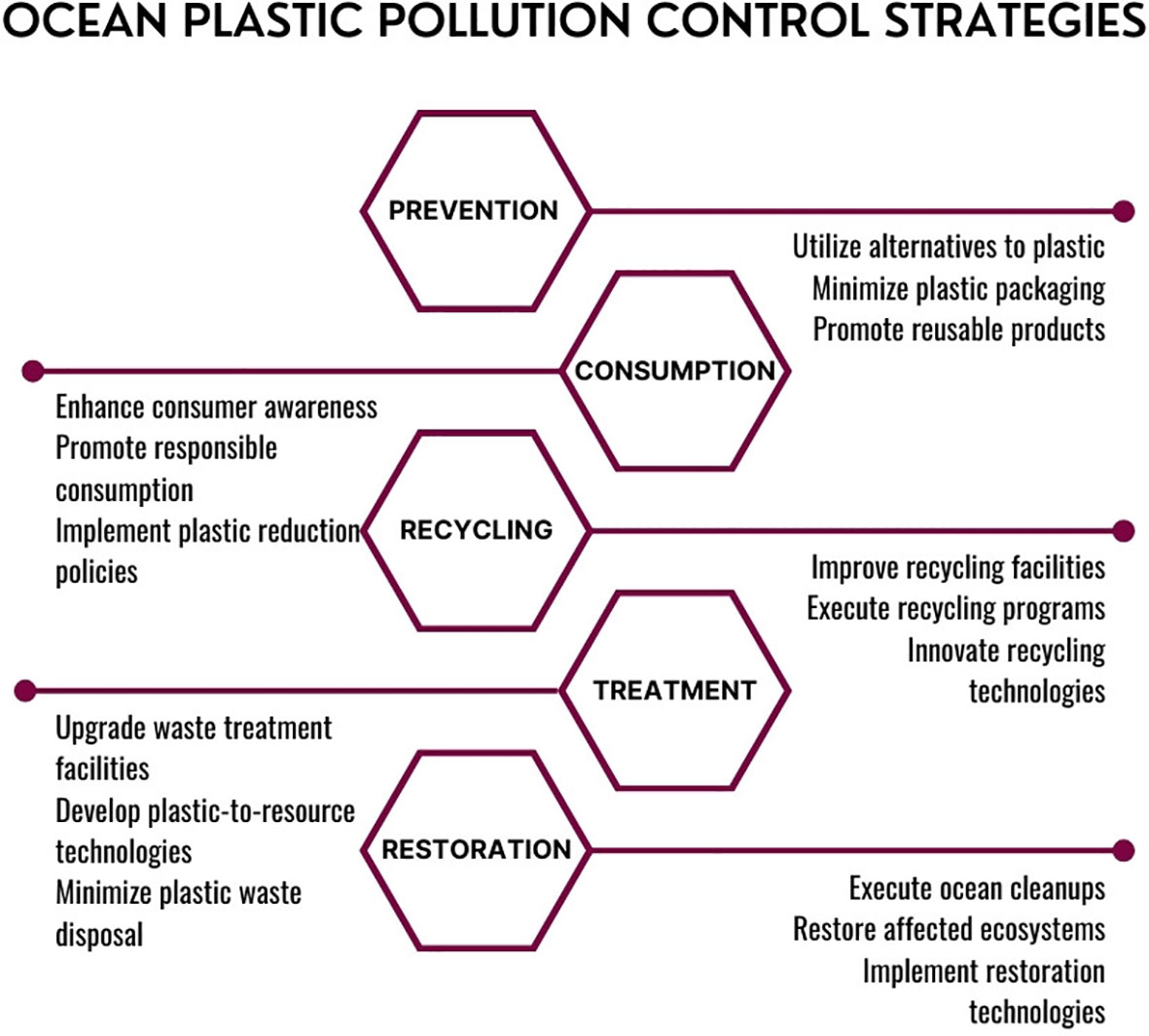
Figure 9 Ocean plastic pollution control strategies. The diagram outlines multi-tiered approaches ranging from prevention and consumption to recycling treatment and restoration. Strategies include but are not limited to utilizing alternatives to plastic, enhancing consumer awareness, improving recycling facilities, and executing ocean cleanups.
To address the problem of plastic waste in marine environments, a range of solutions are needed, including improved waste management systems, the development of sustainable alternatives to plastic, and greater public awareness and engagement. There is also a need for more research into the distribution and impacts of plastic waste in marine environments, as well as the development of innovative technologies and approaches to mitigate the problem. The United Nations has identified the reduction of marine litter, including plastic waste, as a key target in the Sustainable Development Goals (SDGs) (United Nations General Assembly, 2015), highlighting the urgent need for global action to address this pressing environmental challenge.
In addition, a study found that reducing plastic waste by 50% in the ten rivers that contribute the most plastic waste to the ocean could reduce global plastic pollution by 45% (Schmidt et al., 2017). The study highlights the importance of addressing the sources of plastic waste on land in order to reduce the amount of plastic that enters the ocean. Other efforts include the implementation of regulations and policies to reduce plastic waste, such as plastic bag bans and extended producer responsibility. A study conducted by CalRecycle, the agency responsible for enforcing waste management laws in California, found that in the six months following the implementation of a plastic bag ban, in 86 percent of transactions, customers brought their own bags and didn’t purchase a paper or reusable bag. As a result, there was an 85 percent reduction in the number of plastic bags and a 61 percent reduction in the number of paper bags provided to customers (CalRecycle, 2013). However, the effectiveness of these measures may vary depending on the context and implementation.
Research and innovation are being carried out to develop new technologies that can help reduce plastic waste and clean up the oceans. For example, the Ocean Cleanup, a nonprofit organization, has developed a system to collect plastic waste from the oceans using a floating barrier and conveyor belt (https://theoceancleanup.com/; Eriksen et al., 2014). Another innovative solution is biodegradable plastic, which can break down naturally in the environment, reducing the amount of plastic waste that ends up in the oceans (Shen et al., 2020). In addition to technological innovations, education and awareness campaigns are essential in reducing plastic waste and preventing pollution. One study found that increasing environmental awareness and education can reduce the amount of plastic waste generated by individuals (Liu et al., 2023). Governments and organizations can also implement policies and regulations to reduce plastic production and promote sustainable alternatives, such as banning single-use plastics or implementing extended producer responsibility programs (Knoblauch and Mederake, 2021).
Innovative technologies are being proposed as a means to tackle the issue of plastic waste in the ocean. These include the use of artificial intelligence (AI) for monitoring and robotic technologies for waste removal (Figure 10). We proposed several mitigation measures with application of the AI tool, which includes (i) plastic sorting and recycling, (ii) plastic detection, (iii) supply chain optimization, (iv) predictive models, (v) bioplastics R&D, and (vi) public education and engagement. It is worthwhile to invest the AI tool to improve the efficiency of plastic sorting and recycling.
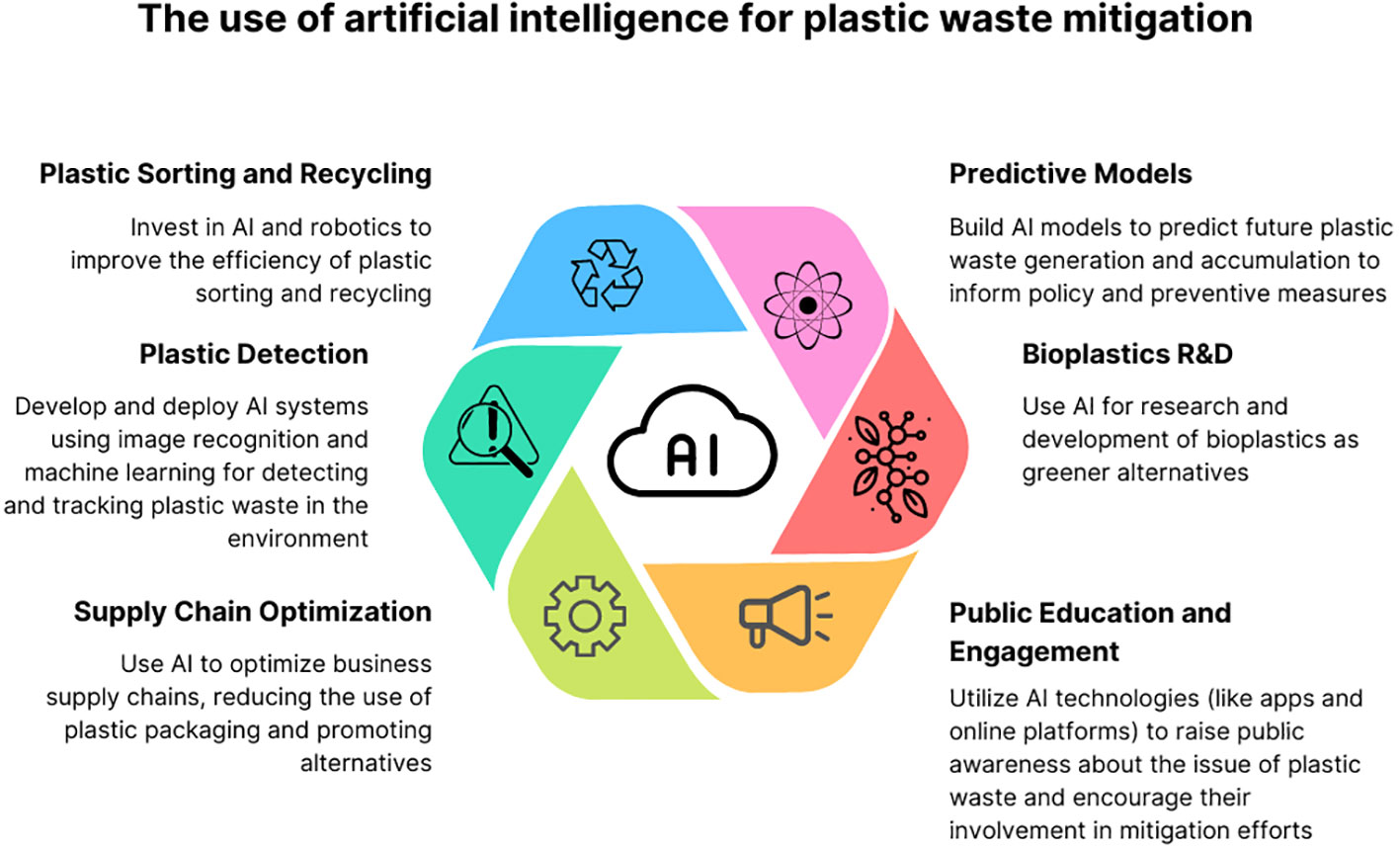
Figure 10 Potential applications of artificial intelligence (AI) for plastic waste mitigation. The diagram covers key areas such as plastic sorting and recycling, plastic detection, supply chain optimization, predictive modeling, bioplastics research & development, and public education & engagement. It showcases how AI and related technologies can enhance efficiency, track waste, and promote sustainable alternatives.
An example of such innovative strategy includes deploying unmanned surface vehicles fitted with cameras and sensors, designed to detect and extract plastic waste from marine environments (Yuan et al., 2023). Other technologies, such as booms and barriers, can also be used to capture plastic waste in rivers and other waterways before it enters the ocean (Schmidt et al., 2017).
Community engagement and awareness-raising campaigns are also important strategies for mitigating marine plastics. The involvement of local communities in beach clean-ups and recycling programs can help reduce the amount of plastic waste that enters the ocean (Callos, 2019). Educational programs and campaigns can also help raise awareness about the impact of marine plastics on the environment and encourage individuals to reduce their plastic consumption and properly dispose of plastic waste (Liu et al., 2023).
In summary, there are a variety of control measure strategies available to mitigate marine plastics, including reducing plastic waste at its source, developing sustainable alternatives to plastic, using innovative technologies to remove plastic waste from the ocean, and engaging communities through education and awareness-raising campaigns. However, a multi-faceted approach is needed to effectively address this global problem, and continued research and development in this area is necessary.
4.5 Urgent action for reducing plastic
Urgent action is needed to reduce plastic waste and prevent further damage to marine ecosystems and human health. The issue of plastic pollution has gained global attention in recent years, leading to increased awareness and efforts to address the problem. Reducing plastic waste requires a combination of strategies, including reducing plastic production, improving waste management systems, and promoting the use of sustainable alternatives to plastic (Geyer et al., 2017).
Governments and industry play a crucial role in reducing plastic waste. Many countries have implemented policies to ban or reduce the use of single-use plastics, such as plastic bags and straws. For example, in 2019, the European Union implemented a ban on single-use plastics, including straws, cutlery, and cotton buds (Commission, E, 2019). Similarly, many companies have made commitments to reduce their plastic waste, such as using more recycled materials and designing products for reusability. Individuals can also make a difference in reducing plastic waste. Simple actions, such as using a reusable water bottle, bringing a reusable bag to the grocery store, and avoiding single-use plastics, can have a significant impact on reducing plastic waste. Education and awareness campaigns can also help to encourage individuals to adopt more sustainable practices.
Bans on single-use plastics have been implemented in many countries and cities worldwide, and they have shown to be effective in reducing plastic waste. A study conducted in San Francisco found that the ban on plastic bags reduced the usage of plastic bags by 72% (Hoornweg et al., 2013). Product redesign is another strategy that can reduce plastic waste. For example, Coca-Cola has introduced a plant-based bottle made from sugarcane that can reduce the company’s reliance on fossil fuel-based plastics (Coca-Cola, 2019). Recycling programs are also effective in reducing plastic waste. In Australia, the National Recycling Scheme has led to the collection and recycling of 2.7 million tonnes of plastic waste (National Plastics Plan, 2021).
In addition to these strategies, public awareness and education are crucial to reduce plastic pollution. Technological advancements in plastic recycling and biodegradable plastics can also help reduce plastic pollution. For instance, researchers have developed a biodegradable plastic made from cellulose and chitin that can be used in food packaging (Yu et al., 2020). These strategies and technologies have the potential to significantly reduce plastic waste and mitigate the negative impacts of plastic pollution on the environment and human health.
In conclusion, urgent action is needed to reduce plastic waste and prevent further damage to marine ecosystems and human health. This requires a global effort, with governments, industry, and individuals all playing a role in reducing plastic waste and promoting sustainable alternatives.
5 Conclusions
Our results highlight the urgent need for global action to reduce plastic waste and prevent further harm to our oceans. The high levels of plastic production and emissions, particularly from Asia, emphasize the importance of international cooperation to address this issue. Efforts to reduce plastic waste should focus on improving waste management and recycling systems, as well as encouraging the development of alternative materials to replace single-use plastics. The role of rivers as major contributors to plastic pollution underscores the need for riverine plastic management initiatives. Finally, the presence of microplastics in the surface ocean and plastic particles across the world surface ocean highlights the need for further research to understand the long-term impacts of plastic pollution on marine ecosystems and human health. We also provided several potential applications of A.I. technology in effective mitigation of plastic pollution in a global level.
Data availability statement
Publicly available datasets were analyzed in this study. This data can be found here: https://ourworldindata.org/plastic-pollution.
Author contributions
R-SY: Validation, Writing – review & editing. Y-FY: Conceptualization, Methodology, Writing – original draft. SS: Formal Analysis, Visualization, Writing – original draft.
Funding
The author(s) declare financial support was received for the research, authorship, and/or publication of this article. This research was supported by the Scientific Research Foundation of Jimei University, China under Grant No. C622005/4411.
Acknowledgments
This investigation was supported in part by National Taiwan Normal University, School of Science (BISBE Lab) to SS.
Conflict of interest
The authors declare that the research was conducted in the absence of any commercial or financial relationships that could be construed as a potential conflict of interest.
Publisher’s note
All claims expressed in this article are solely those of the authors and do not necessarily represent those of their affiliated organizations, or those of the publisher, the editors and the reviewers. Any product that may be evaluated in this article, or claim that may be made by its manufacturer, is not guaranteed or endorsed by the publisher.
Supplementary material
The Supplementary Material for this article can be found online at: https://www.frontiersin.org/articles/10.3389/fmars.2023.1305091/full#supplementary-material
References
Abubakar I. R., Maniruzzaman K. M., Dano U. L., AlShihri F. S., AlShammari M. S., Ahmed S. M. S., et al. (2022). Environmental sustainability impacts of solid waste management practices in the global south. Int. J. Environ. Res. Public Health 19 (19), 12717. doi: 10.3390/ijerph191912717
Andrady A. L. (2011). Microplastics in the marine environment. Mar. pollut. Bull. 62 (8), 1596–1605. doi: 10.1016/j.marpolbul.2011.05.030
Beaumont N. J., Aanesen M., Austen M. C., Börger T., Clark J. R., Cole M., et al. (2019). Global ecological, social and economic impacts of marine plastic. Mar. pollut. Bull. 142, 189–195. doi: 10.1016/j.marpolbul.2019.03.022
Bergmann M., Collard F., Fabres J., Gabrielsen G. W., Provencher J. F., Rochman C. M., et al. (2022). Plastic pollution in the arctic. Nat. Rev. Earth Environ. 3 (5), 323–337. doi: 10.1038/s43017-022-00279-8
Breitburg D., Levin L. A., Oschlies A., Grégoire M., Chavez F. P., Conley D. J., et al. (2018). Declining oxygen in the global ocean and coastal waters. Science 359 (6371), eaam7240. doi: 10.1126/science.aam7240
Callos N. (2019) Stop plastic pollution: environment, beach, and ocean cleanup volunteering. Available at: https://www.volunteerforever.com/article_post/stop-plastic-pollution-environment-beach-and-ocean-cleanup-volunteering/ (Accessed 27 June 2023).
CalRecycle (2013) Plastic bag bans: analysis of economic and environmental impacts. (Accessed 27 June 2023).
Coca-Cola (2019) Introducing a world-first: A coke bottle made with plastic from the sea. Available at: https://www.coca-colacompany.com/media-center/a-coke-bottle-made-with-plastic-from-the-sea (Accessed 27 June 2023).
Commission, E (2019) European commission. Available at: https://commission.europa.eu/index_en (Accessed 27 June 2023).
Cózar A., Echevarría F., González-Gordillo J. I., Irigoien X., Úbeda B., Hernández-León S., et al. (2014). Plastic debris in the open ocean. Proc. Natl. Acad. Sci. U. S. A. 111 (28), 10239–10244. doi: 10.1073/pnas.1314705111
Eriksen M., Lebreton L. C. M., Carson H. S., Thiel M., Moore C. J., Borerro J. C., et al. (2014). Plastic Pollution in the World's Oceans: More than 5 Trillion Plastic Pieces Weighing over 250,000 Tons Afloat at Sea. PloS One 9 (12), e111913. doi: 10.1371/journal.pone.0111913
Europe P. (2020) Plastics – the facts 2020. Available at: https://plasticseurope.org/wpcontent/uploads/2021/09/Plastics_the_facts-WEB-2020_versionJun21_final.pdf (Accessed 27 June 2023).
Ford H. V., Jones N. H., Davies A. J., Godley B. J., Jambeck J. R., Napper I. E., et al. (2022). The fundamental links between climate change and marine plastic pollution. Sci. Total Environ. 806 (Pt1), 150392. doi: 10.1016/j.scitotenv.2021.150392
Gall S. C., Thompson R. C. (2015). The impact of debris on marine life. Mar. pollut. Bull. 92 (1), 170–179. doi: 10.1016/j.marpolbul.2014.12.041
Galloway T. S., Cole M., Lewis C. (2017). Interactions of microplastic debris throughout the marine ecosystem. Nat. Ecol. Evol. 1 (5), 116. doi: 10.1038/s41559-017-0116
Geyer R., Jambeck J. R., Law K. L. (2017). Production, use, and fate of all plastics ever made. Sci. Adv. 3 (7), e1700782. doi: 10.1126/sciadv.1700782
Hoornweg D., Bhada-Tata P., Kennedy C. (2013). Environment: Waste production must peak this century. Nature 502 (7473), 615–617. doi: 10.1038/502615a
Jambeck J. R., Geyer R., Wilcox C., Siegler T. R., Perryman M., Andrady A., et al. (2015). Marine pollution. Plastic waste inputs from land into the ocean. Science 347 (6223), 768–771. doi: 10.1126/science.1260352
Jones J. S., Porter A., Muñoz-Pérez J. P., Alarcón-Ruales D., Galloway T. S., Godley B. J., et al. (2021). Plastic contamination of a Galapagos Island (Ecuador) and the relative risks to native marine species. Sci. Total Environ. 789, 147704. doi: 10.1016/j.scitotenv.2021.147704
Knoblauch D., Mederake L. (2021). Government policies combatting plastic pollution. Curr. Opin. Toxicol. 28, 87–96. doi: 10.1016/j.cotox.2021.10.003
Lamb J. B., van de Water J. A., Bourne D. G., Altier C., Hein M. Y., Fiorenza E. A., et al. (2017). Seagrass ecosystems reduce exposure to bacterial pathogens of humans, fishes, and invertebrates. Science 355 (6326), 731–733. doi: 10.1126/science.aal1956
Lebreton L., Egger M., Slat B. (2019). A global mass budget for positively buoyant macroplastic debris in the ocean. Sci. Rep. 9 (1), 12922. doi: 10.1038/s41598-019-49413-5
Liu J., Hu Z., Du F., Tang W., Zheng S., Lu S., et al. (2023). Environment education: A first step in solving plastic pollution. Front. Environ. Sci. 11. doi: 10.3389/fenvs.2023.1130463
Mallick S. K., Pramanik M., Maity B., Das P., Sahana M. (2021). Plastic waste footprint in the context of COVID-19: Reduction challenges and policy recommendations towards sustainable development goals. Sci. Total Environ. 796, 148951. doi: 10.1016/j.scitotenv.2021.148951
Meijer L. J. J., van Emmerik T., van der Ent R., Schmidt C., Lebreton L. (2021). More than 1000 rivers account for 80% of global riverine plastic emissions into the ocean. Sci. Adv. 7 (18), eaaz5803. doi: 10.1126/sciadv.aaz5803
Moshood T. D., Nawanir G., Mahmud F., Mohamad F., Ahmad M. H., AbdulGhani A. (2022). Biodegradable plastic applications towards sustainability: A recent innovations in the green product. Clean. Eng. Technol. 6, 100404. doi: 10.1016/j.clet.2022.100404
National Plastics Plan (2021). Available at: https://www.agriculture.gov.au/sites/default/files/documents/national-plastics-plan-2021.pdf (Accessed 27 June 2023).
NOAA, National Centers for Environmental Information (NCEI), Microplastics Database (2022) Marine microplastic concentration map portal. Available at: https://experience.arcgis.com/experience/b296879cc1984fda833a8acc93e31476 (Accessed 27 June 2023). Marine Microplastic Concentration Map Portal.
Ritchie H., Roser M. (2018) Plastic Pollution (Our World in Data). Available at: https://ourworldindata.org/plastic-pollution (Accessed 27 June 2023).
Rochman C. M., Browne M. A., Halpern B. S., Hentschel B. T., Hoh E., Karapanagioti H. K., et al. (2013). Policy: Classify plastic waste as hazardous. Nature 494(7436), 169–171. doi: 10.1038/494169a
Schmidt C., Krauth T., Wagner S. (2017). Export of plastic debris by rivers into the sea. Environ. Sci. Technol. 51 (21), 12246–12253. doi: 10.1021/acs.est.7b02368
Shen M., Song B., Zeng G., Zhang Y., Huang W., Wen X., et al. (2020). Are biodegradable plastics a promising solution to solve the global plastic pollution? Environ. pollut. 263 (Pt A), 114469. doi: 10.1016/j.envpol.2020.114469
Skoric M. M., Zhang N., Kasadha J., Tse C. H., Liu J. (2022). Reducing the use of disposable plastics through public engagement campaigns: an experimental study of the effectiveness of message appeals, modalities, and sources. Int. J. Environ. Res. Public Health 19 (14), 8273. doi: 10.3390/ijerph19148273
Smith M., Love D. C., Rochman C. M., Neff R. A. (2018). Microplastics in seafood and the implications for human health. Curr. Environ. Health Rep. 5 (3), 375–386. doi: 10.1007/s40572-018-0206-z
Suaria G., Avio C. G., Mineo A., Lattin G. L., Magaldi M. G., Belmonte G., et al. (2016). The Mediterranean Plastic Soup: synthetic polymers in Mediterranean surface waters. Sci. Rep. 6, 37551. doi: 10.1038/srep37551
Teuten E. L., Saquing J. M., Knappe D. R., Barlaz M. A., Jonsson S., Björn A., et al. (2009). Transport and release of chemicals from plastics to the environment and to wildlife. Philos. Trans. R. Soc Lond. B. Biol. Sci. 364 (1526), 2027–2045. doi: 10.1098/rstb.2008.0284
United Nations General Assembly. (2015). Transforming our world: the 2030 agenda for sustainable development. Available at: https://sdgs.un.org/2030agenda (Accessed 27 June 2023)
Van Cauwenberghe L., Janssen C. R. (2014). Microplastics in bivalves cultured for human consumption. Environ. pollut. 193, 65–70. doi: 10.1016/j.envpol.2014.06.010
Wilcox C., Van Sebille E., Hardesty B. D. (2015). Threat of plastic pollution to seabirds is global, pervasive, and increasing. Proc. Natl. Acad. Sci. U.S.A. 112 (38), 11899–11904. doi: 10.1073/pnas.1502108112
Yu Z., Ji Y., Bourg V., Bilgen M., Meredith J. C. (2020). Chitin- and cellulose-based sustainable barrier materials: a review. Emerg. Mater. 3, 919–936. doi: 10.1007/s42247-020-00147-5
Yuan L., Buzoglu Kurnaz L., Tang C. (2021). Alternative plastics. Nat. Sustain. 4 (10), 837–838. doi: 10.1038/s41893-021-00750-2
Keywords: plastic pollution, marine ecosystems, control measures, carbon credit, recycling, sustainable development
Citation: Yu R-S, Yang Y-F and Singh S (2023) Global analysis of marine plastics and implications of control measure strategies. Front. Mar. Sci. 10:1305091. doi: 10.3389/fmars.2023.1305091
Received: 30 September 2023; Accepted: 27 November 2023;
Published: 11 December 2023.
Edited by:
Mehran Idris Khan, Dalian Maritime University, ChinaReviewed by:
Duminda Senevirathna, Uva Wellassa University, Sri LankaYi-Che Shih, National Cheng Kung University, Taiwan
Copyright © 2023 Yu, Yang and Singh. This is an open-access article distributed under the terms of the Creative Commons Attribution License (CC BY). The use, distribution or reproduction in other forums is permitted, provided the original author(s) and the copyright owner(s) are credited and that the original publication in this journal is cited, in accordance with accepted academic practice. No use, distribution or reproduction is permitted which does not comply with these terms.
*Correspondence: Sher Singh, aHNoZXJAbnRudS5lZHUudHc=; Ying-Fei Yang, ZjAwNjIyMDM3QG50dS5lZHUudHc=
†These authors have contributed equally to this work
 Ren-Shou Yu
Ren-Shou Yu Ying-Fei Yang
Ying-Fei Yang Sher Singh
Sher Singh